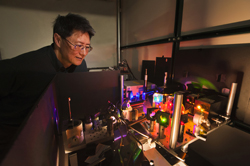ALBUQUERQUE, N.M. — Two researchers have reprised in the journal Energy Policy their groundbreaking finding that improvements in lighting — from candles to gas lamps to electric bulbs — historically have led to increased light consumption rather than lower overall energy use by society.
In an article in the journal Energy Policy, Sandia researcher Jeff Tsao and Harry Saunders of The Breakthrough Institute in Oakland, Calif., predicted in 2010 that the same phenomenon might apply to light-emitting diodes (LEDs), poised to take over from the Edison light bulb as the next, more efficient light source of choice.
But their main point, as three centuries have shown, was that increased light availability leads to increased productivity. Workers are no longer forced to stop shortly after nightfall, as they had in primitive, candle-illuminated huts, but instead could continue producing through the night in homes, offices, factories, and even at outdoor locations not serviced by power lines.
The original paper, titled “Solid-state lighting: an energy-economics perspective,” drew attention to the increased productivity made possible by better lighting, rather than societal energy-savings mistakenly cited as a feature of improved lighting technologies.
Misinterpretations of the original paper by two widely read international media outlets led to the confusion that Tsao and his co-authors had shown that lighting efficiency improvements were no improvements at all. This is because reductions in neither overall energy usage nor overall lighting costs would occur.
The researchers, in the upcoming article, titled “Rebound effects for lighting,” said the 2010 article generated both interest and confusion in the popular press and in the blogosphere. “This communication seeks to clarify some of this confusion for the particular benefit of energy economists and energy policy specialists,” they wrote.
The new article appears under “Articles in Press” on the Energy Policy website.
“We were motivated to publish something, even if short, in Energy Policy, because that journal serves a community very different from that served by the Journal of Physics, where our original article was published,” Tsao says. “We thought that many in the energy economics community were still unaware of the work, and of the benefit — even when there is no direct energy-use savings — of energy efficiency and other welfare-enhancing technologies.”
Other authors of the 2010 article included Sandia researchers Mike Coltrin, Jerry Simmons and Randy Creighton (retired). Harry Saunders is also associated with Decision Processes Inc. in Danville, Calif.
The work was supported by Sandia’s Solid-State Lighting Science Energy Frontier Research Center, which is funded by DOE’s Office of Basic Energy Sciences.
